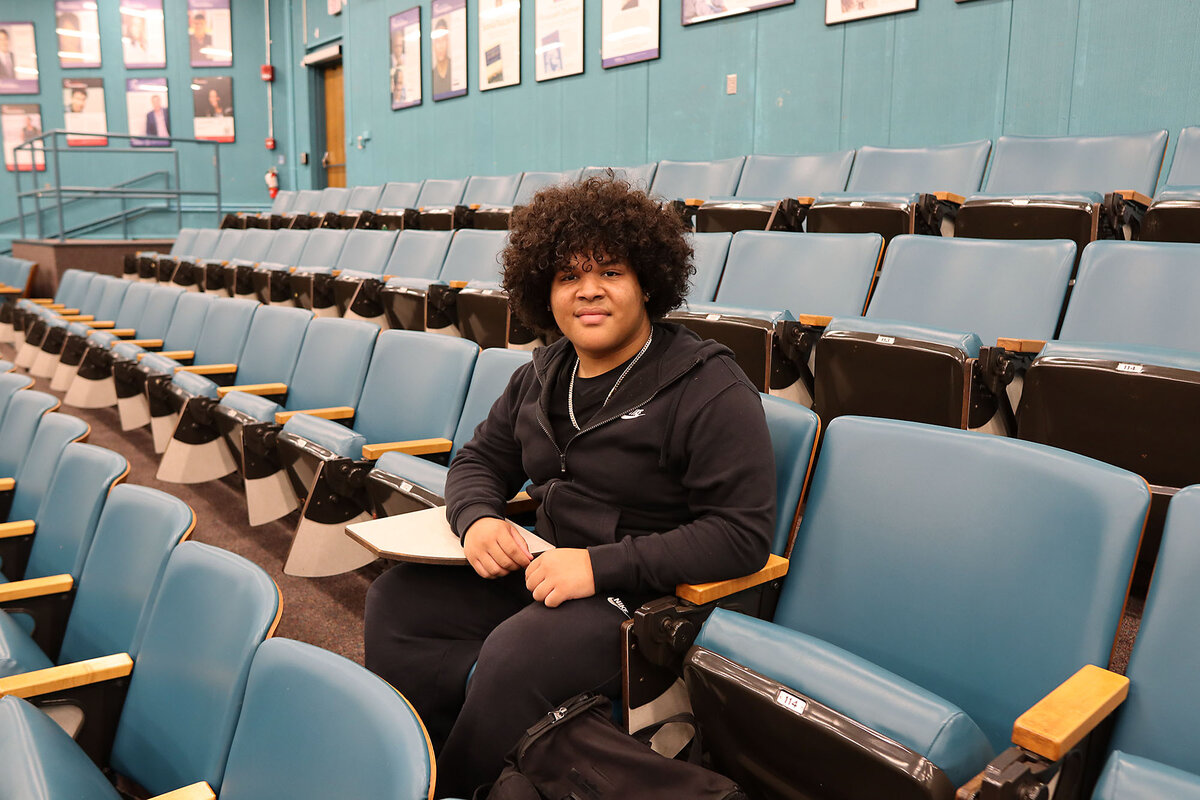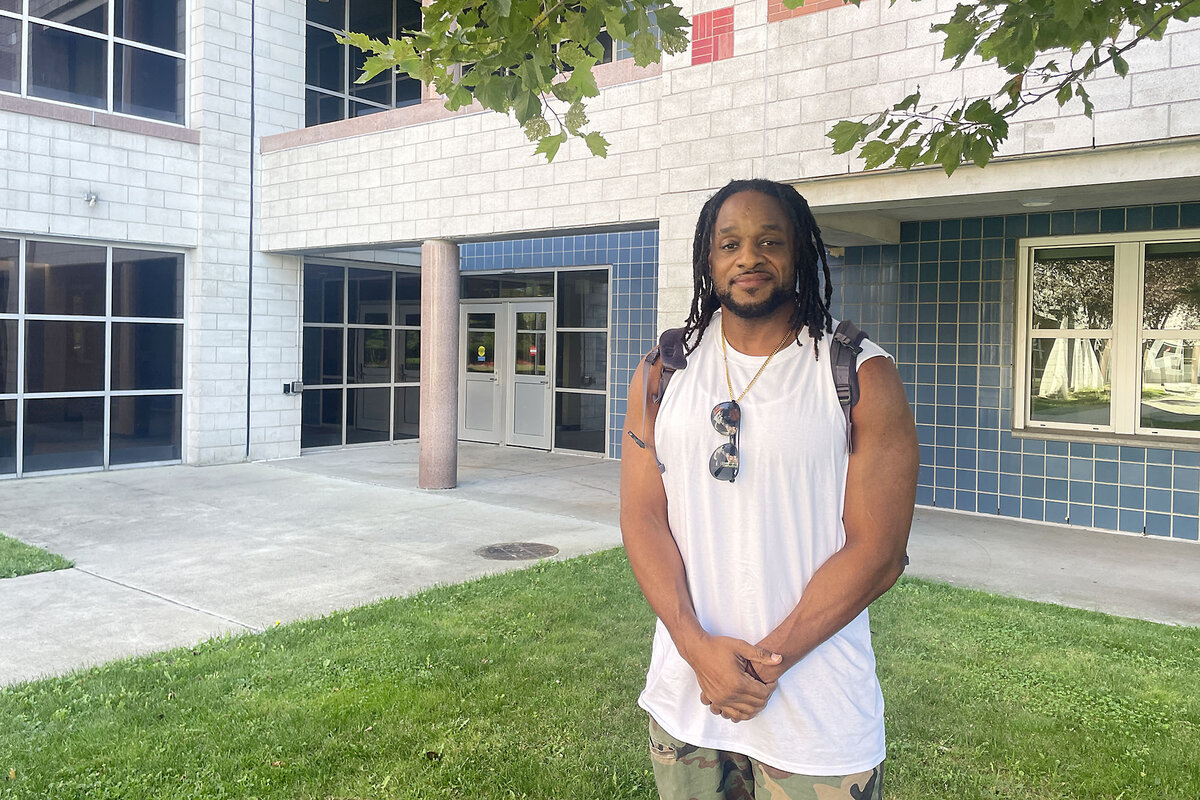Massachusetts needs more workers. Enter free community college.
Loading...
| Boston
Cambridge resident Tyrie Daniel was almost at the finish line when he dropped out of Bunker Hill Community College in 2015.
He just needed 16 more credits to transfer to a four-year school. But life just came hard. His family was scammed, he says, and their Social Security numbers were stolen.
“When your stomach keeps growling and you have nothing in your fridge, you can’t even focus on school,” says Mr. Daniel, who is 33 years old. His family was struggling to pay bills at home and provide for their household of six.
Why We Wrote This
A story focused onWhile the story of higher education has been one of ever-climbing costs, a sea change has been spreading at U.S. community colleges. When Massachusetts went tuition-free this fall, it wasn’t the first, or fifth, or even 15th state to do so.
The family needed an extra hand. And at the time, he says, “the extra hand was me. So I had to choose between school or food on the table.”
With five classes to go, he dropped out. He worked as a cleaner, in his family’s spice business, and in real estate. More than thrice, he contemplated returning to school. But he couldn’t reenroll until his overdue fees were paid.
Now, Mr. Daniel is back at Bunker Hill. This time, he is debt-free and his tuition is covered by MassReconnect. The program, which started in 2023, made community college tuition free for Massachusetts residents over 25 who don’t have a degree. Mr. Daniel says he feels both enormous relief and a new motivation to succeed.
“One of the huge benefits of MassReconnect for me is not having that financial pressure,” says the cybersecurity major. “Now, I’m actually back in school to further my career in something that I really am interested in and passionate about.”
This fall, Massachusetts is widening the halls of higher education even further. For the first time, all residents with a high school diploma can attend one of its 15 community colleges for free. Since Tennessee first pioneered tuition-free community college for all in 2017, it has spread rapidly in both red and blue states.
With the launch of MassEducate, the Bay State becomes the 20th to offer tuition-free community college regardless of age, income, or GPA. Another 14 states offer programs targeting specific demographics, such as people over 25, or high-demand majors, such as nursing.
“When we invest in institutions, in schools and colleges, that pays off in the long run. The cost-benefit ratio, for the individual and the society, is always positive,” says Douglas Harris, chair of the economics department at Tulane University and director of the National Center for Research on Education, Access, and Choice.
Professor Harris says promising universal access to community college “wipes away that complexity and the risk and uncertainty that goes with it.”
“Going to college is complicated,” he says. “When people come up against complicated, expensive decisions, they tend to say no. With free community college, you’re sort of reversing it. When it gets cheaper and simpler, it makes people say yes.”
When states started making community college tuition free, enrollment jumped by 10% and degree completion by 11%, according to a 2020 study by the Federal Trade Commission.
“This is going to change family trees for generations to come, for the better,” says Nate Mackinnon, executive director of the Massachusetts Association of Community Colleges.
It’s also coming at a time when sticker shock for four-year schools has never been greater, with tuition alone at institutions such as Northeastern University and Boston University topping $64,000 and $66,000 a year, respectively.
“As the cost of higher education rises, more families cannot afford private colleges,” says Mr. Mackinnon. “More families are turning to public higher education and discovering that these institutions offer excellent quality at an affordable price.”
Why free tuition now? The Bay State needs workers. Massachusetts has 42 available workers for every 100 open jobs, categorizing its workforce shortage as “most severe,” according to the U.S. Chamber of Commerce. Meanwhile, 700,000 residents have some college credits but no degree.
“The shape of the labor force is different and the need for training is strong,” says Pam Eddinger, president of Bunker Hill Community College. “When you think about how you provide an on-ramp for the next generation of workers in this Commonwealth, we are the linchpin.”
In MassReconnect’s first year, 2023-24, some 8,411 students enrolled through MassReconnect. That was a 45% increase in students over 25 from the previous academic year. Overall, the program reversed a decadelong decline in the state’s community college system – bumping enrollment up 9% in one year.
As of this August, with the launch of MassEducate, total enrollment is up another 20% compared with last year.
“It’s like the advertising value of free college is giving you a pretty big bang for your buck,” says David Deming, an economist from the Harvard Kennedy School whose research focuses on higher education and the future of the labor market.
The programs are considered “last dollar scholarships,” meaning they are applied after federal aid reduces tuition and fees for most students.
The challenge in the long term is maintaining the quality of education with more students. “If local colleges themselves are not getting any extra funding to accommodate the influx, the quality of the service itself might decline if the same resources are more thinly [spread] over more students,” says Professor Deming.
“Money was a big concern”
For recent high school graduates like Erick Peguero, free tuition means his family can save money while he takes classes in the hopes of transferring to a four-year program.
“Money was a big concern going into college, and I was considering a gap year,” says Mr. Peguero as he signs up for classes at Bunker Hill Community College on a recent August morning. His sister is already attending the University of Massachusetts Boston.
When he graduated from Brooke High School in June, Mr. Peguero didn’t have plans to go to college this fall. It wasn’t that the resident of the Dorchester neighborhood wasn’t interested, but his family lives in Section 8 low-income housing. When community college became free last month, he jumped at the chance to continue his education.
“I want to set myself up where I can have a future in four years. So this is definitely a huge opportunity for me,” says Mr. Peguero. The high school MVP plans to study electrical engineering and play baseball for the Bunker Hill Bulldogs.
The state set aside $117 million in the budget for MassEducate to build on MassReconnect. Both programs are funded by the “millionaires’ tax,” a 4% surtax on incomes over a million dollars.
“This will open up doors for so many more students,” says Mr. Mackinnon. “But at the same time, there’s a bit of trepidation about how we’ll handle all the students coming through the door.”
Will more students mean more resources?
Klevans Lehens, 45, says he’s living proof that it’s never too late to go back to school.
In the early 2000s, Mr. Lehens, an EMT from Boston, opted to join the workforce to provide for his son instead of pursuing a degree. For the past two years, he’s been taking classes at Roxbury Community College (RCC).
He believes that making tuition free offers a second chance. “It’s a blessing for those who actually want to follow their dream. For me, it’s a sign I’m on the right path,” says Mr. Lehens.
He says he and his son are now attending college at the same time – his son has a full ride scholarship to a Florida university.
“That’s the beauty of life,” says Mr. Lehens in the courtyard at RCC. “You’re not always going to get it the first time, but you can always try again.”
At Roxbury, the recent surge in enrollment is expected to strain existing resources aimed at supporting students. RCC has on-campus wellness programs, tutoring programs, a food pantry, and an emergency gap fund to help students cover basic needs. Other community colleges also provide child care services.
“Providing support beyond the classroom is key to improving student retention and completion,” says Luciano Ramos, executive director of the Center for Economic and Social Justice at RCC. “We’re committed to offering programs and innovations that support our students holistically.”
It’s unclear if these services – which are expected to see increased demand – will receive more funding. Mr. Mackinnon also is concerned about instructors’ salaries.
“You can get a better starting salary as a high school teacher in most cities and towns in the commonwealth,” he says.
But some community college leaders say they welcome the challenges that more students in classes bring.
“I’ve been waiting my entire professional life for this moment,” says Ms. Eddinger. “I’ll be damned if I’m going to turn anyone away. Because if I turn somebody away now, where it takes so much for them to come to me, they may not come back.”










